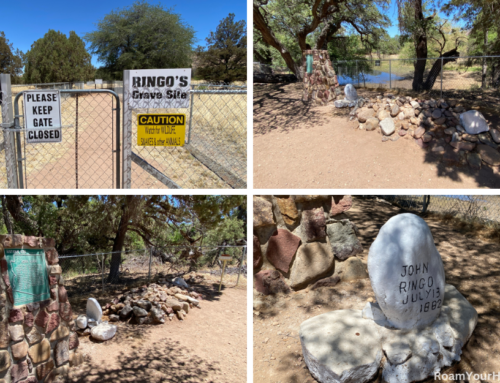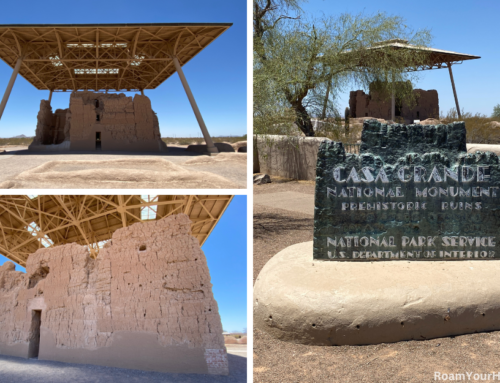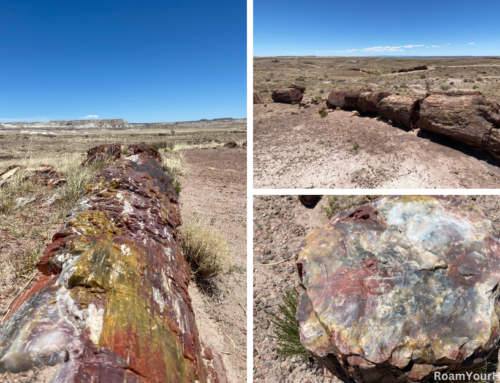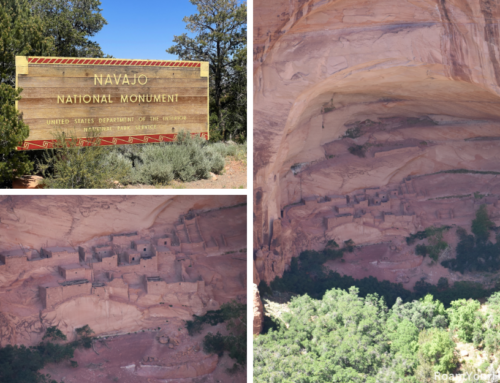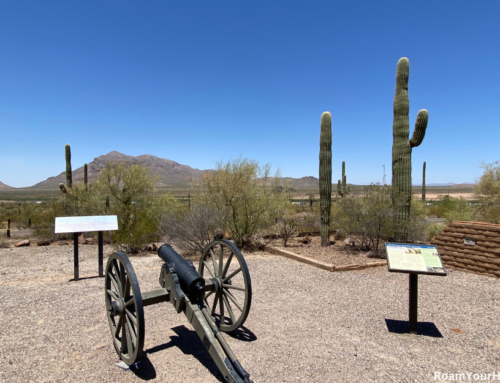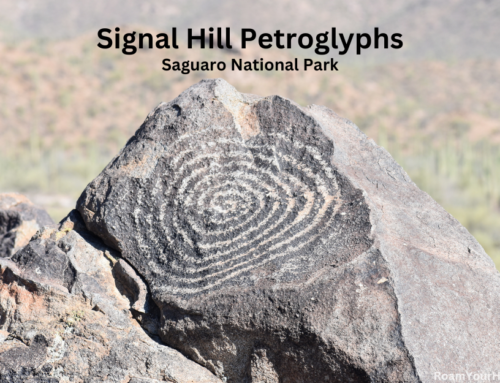
Pipe Spring National Monument: What to see and do while visiting
Pipe Spring National Monument is located in the high desert of northern Arizona. It is between the Grand Canyon and Zion National Park. This lesser-known site is a worthwhile stop for history buffs, nature lovers, and anyone looking to experience the rugged beauty of the American Southwest.
Visiting Pipe Spring National Monument
Water is precious in northern Arizona. For centuries, Pipe Spring has been a crucial water source. First, sustaining the Kaibab Band of Paiute Indians, who relied on its fresh water for survival. Then, when Mormon settlers arrived in the late 19th century, they built Windsor Castle, a fortified ranch house, to protect the spring and provide a base for cattle ranching. Today, you can tour Windsor Castle, explore historical artifacts, and learn how Pipe Spring was pivotal in shaping the region’s past.
We pulled into the parking lot late on a summer weekend afternoon. The monument was only open for another hour and a half or so. We were coming from St. George, about an hour’s drive away, on our way to Page, another hour and a half away. Pipe Springs is remote. To my surprise, the parking lot was bigger than I expected and not quite halfway full.
Getting out of the car was a shock to the system. It was a very scorching hot afternoon, with just enough of a breeze to taste the Arizona red dust.
My wife and I were unfamiliar with the park service site, so we headed towards the visitor center.
Pipe Spring Visitor Center
The visitor center and museum had great exhibits detailing the lives of the Native American inhabitants, early pioneers, and the struggles over water rights that have defined the area’s history. I asked a ranger if we had enough time to visit, and she said sure, the site is not that big, but you will want to get moving now.
It’s a short walk from the VC to the homesteads. There is no shade. To the left, you pass an old orchard with historic varieties of peach, apple, apricot, plum, crab-apple trees, and grapes. To the right is a garden planted with common crops enjoyed by pioneers and Native Americans. There was a giant Texas Longhorn in the corral near the garden. It looked just as hot as we were!
Next, we walked over to the East Cabin, which has excellent exhibits on cowboying and early pioneer life. The East Cabin was built as a “guard house” in 1868 by the Mormon militia after a series of raids by the Navajo on Mormon settlements in the mid-1860s.
These raids by the Navajo picked up after the U.S. Army campaigns against the Navajo in 1863-64. Led by Kit Carson, they decimated Navajo herds of sheep and cattle, villages, orchards, and social structure.
During one raid in January of 1866, James Whitemore, the first Mormon settler at Pipe Spring, and his ranch hand, Robert McIntyre, were killed. The Mormons claimed that throughout the 1860s, the Navajos “had driven off one thousand head of horses, mules, and cattle and about twenty-five hundred sheep. They also killed eight or ten citizens on these raids.”

Brigham Young Orders the Construction of a Fort
In 1870, Brigham Young, the second prophet and president of The Church of Jesus Christ of Latter-day Saints, during a visit to Pipe Spring took action against the raids. Young ordered the construction of a fortified ranch house at Pipe Spring.
Windsor Castle
The ranch house or fort was designed as headquarters for a tithing cattle ranch and as protection from attacks. It was constructed directly over Pipe Spring from 1870 to 1872. It was nicknamed Winsor Castle in honor of the ranch’s first manager and one of its builders, Anson Perry Winsor. The sandstone used in Windsor Castle was quarried on the hillside just to the west of the fort.
During our visit, Windsor Castle was open for self-guided tours of the home. An NPS Volunteer was in the home courtyard to answer any questions. She explained that all of the rooms are decorated as they would have looked in the 1870s.
Courtyard
We walked through the big double wooden doors into Winsor Castle’s courtyard. At each end, two main buildings and gated walls frame the courtyard, which is ringed by an expansive second-floor porch on two sides and joined by a narrow catwalk at the west end of the fort.
The second-floor veranda was significant for multiple reasons. First, it offers ranch families and visitors shade on the relentless hot days, but is also was access to shooting positions over the walls.
Parlor
After walking around the courtyard for a bit, we entered the parlor. It is on the ground floor of the “family side” of Winsor Castle, or the north building.
It was used in essentially the same way we use a family room today. There were shelves for a small library of books, an area for the ranch manager’s desk, and perhaps a spinning wheel. The spring for which Pipe Spring is named flowed underneath the parlor’s floorboards.
The Kitchen
Next, we checked out the kitchen, which was busy at Windsor Castle. Families, guests, and others were fed in shifts, and the stove was nearly always warm.
The Meeting Room and Master Bedroom
The rooms above the parlor and kitchen were used as family living areas. The meeting room was for the children, but it also was used for school and church services.
One thing that struck me was both rooms had gunports on the walls. A reminder that while this was living quarters, it was also designed to keep its inhabitants living.
Telegraph Room
On the second floor of the other building is the Telegraph Room. Winsor Castle was home to the first telegraph station in the Territory of Arizona. In 1861 the transcontinental telegraph line was completed. It passed through Salt Lake City and revolutionized communications. Information from Washington, D.C., or San Francisco that once took weeks or months to reach Utah arrived in only a few minutes. This was only from east to west.
Brigham Young realized the directional difficulties, as most Mormon settlements were north and south of Salt Lake City, and ordered the construction of the Deseret Telegraph.
The telegraph line in this region ran from Toquerville, Utah, to Rockville (near Zion National Park), then to Pipe Spring and on to Kanab, Utah. Pipe Spring has what is believed to be a section of the original wire used in the Deseret Telegraph system.
Middle and Southeast Bedroom
These rooms were used by workers, visitors, and guests at the ranch. These rooms also played a role in Winsor Castle’s use as a safe house to shelter polygamists. When the Edmunds Act passed in 1882 the federal government began cracking down on polygamy.
The Mormons quickly realized that if a polygamist couldn’t be found, he couldn’t be convicted and sent to prison. Additionally, it was hard to get a guilty verdict for polygamy if the plural wife or wives could not be located.
Safe houses were established to shelter polygamists or their wives as they stayed ahead of the federal marshals.
Pipe Spring became an important safe house for wives of targeted men in Southern Utah, as it was across the territorial line in Arizona. One plural wife said this of her move to Pipe Spring, “So about the year 1886, I moved to Pipe Spring. In other words, I went to prison to keep my husband out.”
Cheese Room
Under the bedroom is the cheese room. This room produced between 50 to 60 pounds of cheese a day. Most of which was shipped to St. George to be served to workers building the temple there.
The Spring Room
The Spring Room is on the ground level under the Telegraph Room. While it’s named the “spring room,” Pipe Spring bubbled out of the sandstone underneath the parlor floor. It was directed across the courtyard and emptied into the trough in the spring room. From here, the water exited the fort and fed the ponds.
The Spring Room was also used for cold storage. The cool flowing water kept the room 48 to 50 degrees year-round. This is where the milk from 80 to 100 cows was stored.
“it may taste a bit amphibian.”
This room was the highlight of our visit. It was fun to see the reason for the settlement and the fort built on top of it up close.
While we were in there, the NPS volunteer walked in. “Do you have any questions about the Spring Room or anything else you saw?” She politely asked. “I actually do,” I responded. My curious mind just had to know, “Can you still drink the water?”
She said with a bit of a smile. “I suppose you could; I don’t THINK it will kill you.” Her smile turned into a light chuckle. “But keep in mind the pipes are very old and likely made of lead. Also, salamanders have made the pipes their home… so it may taste a bit… amphibian.”
Laughing out loud, my wife said, “Well, I guess we are going to pass this time.”
This was the end of the self-guided tour of Windsor Castle; we said goodbye to the volunteer and left the cool spring room to walk outside.
Exploring the Monument
Beyond its historical significance, Pipe Spring National Monument has a wonderful hike. The Ridge Trail is a short, half-mile loop that climbs to the top of the low cliffs overlooking Winsor Castle. The view of the Arizona Strip from the top is spectacular.
Planning a Trip to Pipe Spring National Monument
Pipe Spring National Monument is open year-round, but spring and fall are the best times to visit due to the cooler temperatures. We stayed in the summer; it was incredibly hot.
The monument is off Highway 389, about 20 miles west of Fredonia, Arizona, making it an easy detour for travelers heading to Grand Canyon National Park, Zion National Park, or Lake Powell.
Why You Should Visit the Northern Arizona Park
Pipe Spring National Monument may not be as famous as Arizona’s or nearby Utah’s larger national parks. Still, it offers an authentic experience for those interested in the area’s history and culture. Whether stopping for a quick visit or spending a few hours exploring, you’ll leave with a greater appreciation for the resilience of those who have called this desert landscape home.
So, if you’re planning a Southwest road trip, add Pipe Spring to your itinerary—it’s worth visiting!

